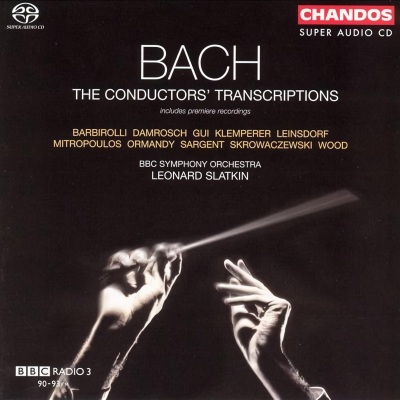
Bach: The Conductors' Transcriptions
A colourful wardrobe for music’s mightiest master - Superb performances and recordings. And there’s not a single arrangement by Stokowski! A good thing, I’d say – especially as Stokowski’s own recordings of his Bach transcriptions are so generously represented on CD. Respighi’s Passacaglia and Fugue opens like a lavish sacramental ceremony. Organ pedals add so much thunder though the softer moments are moulded with great care. Just occasionally you sense the Respighi of the Roman trilogy: at 4'02'', for example, where raucous winds lend a touch of tartness to the texture. The Chandos recording is generally superb, even though momentary overhang obscures the opening bassoon note of the Fugue. It’s a warm, regal statement, quite the opposite of Toscanini’s wild-eyed sermon (which is still tops in my book). Bantock’s Wachet auf uses the brass as a sort of substitute organ, with the strings as decoration. I much preferred it to Honegger’s C major Prelude and Fugue which, like the Schoenberg St Anne that closes the programme, has instrumental lines popping through the surface like so many sore thumbs. The overall canvas favours the sort of primary-coloured palette that Ravel chose for Mussorgsky’s Pictures. Slatkin has recorded Elgar’s blustery Prelude and Fugue before (RCA, 3/89), to equally good effect (though here the bass drum in the Prelude is particularly striking), and his mastery of string sonorities presents the best possible case for Reger’s beautiful O Mensch, bewein’ dein’ Sunde gross. Between them, Vaughan Williams and Arnold Foster manage to make the ‘Giant’ Fugue sound like a dead ringer for the first movement of Bach’s Double Concerto for two violins while Holst’s Fugue a la gigue spurts to a sudden and excited full-tutti close. For me, though, the really big news is Joachim Raff’s Chaconne, where pompous chest-beating is never on the agenda and transparency is a welcome attribute. Just listen to the exultant transition at 6'00'', where full strings take the lead, or the way Raff negotiates woodwinds and pizzicato strings. You could, I suppose, accuse him of making a molehill out of a mountain, but the colour, variety and imagination he brings to bear on the piece are remarkable, and the performance is again superb. Individual listeners will no doubt squabble about this or that preference, just as I will be doing with my colleagues (a cue for a Take Five follow-up review, perhaps?). For this listener, the Respighi, Elgar and Raff costumes are the principal attractions, although the others also deserve an occasional airing. Stokowski remains in a class of his own but when all has been listened to and you think back at what you’ve actually heard, the most lasting memory is of one man, and one man only: JSB himself. Rob Cowan, Gramophone [10/2000]
